Algae Terminology
1/362
There's no tags or description
Looks like no tags are added yet.
Name | Mastery | Learn | Test | Matching | Spaced |
|---|
No study sessions yet.
363 Terms
What are algae?
Mostly oxygen-producing, photosynthetic organisms found in aquatic habitats
Include eukaryotic microscopic and macroscopic species, and prokaryotic cyanobacteria
How are algae distinct from land plants?
Lack key adaptations to terrestrial life that are found in plants
What are cyanobacteria?
Prokaryotic algae
Typically much smaller than eukaryotic cells
What does prokaryotic mean?
Lacks a nucleus and other membrane-bound organelles
How do cyanobacteria live?
Some live alone as solitary cells or as pairs of cells formed after a recent cell division
Other species form colonies
What is mucilage?
An extracellular coating mostly made up of polysaccharides, built from a mixture of sugars with and without nitrogen
Do cyanobacteria have flagella?
No
Why is vertical movement in the water column advantageous for cyanobacteria?
Helps them regulate their exposure to light for photosynthesis
List 3 different cellular mechanisms diverse cyanobacteria use to adjust their position.
Pili
Mucilage and protein fibrils
Gas vesicles
What is the structure and function(s) of pili?
Hair-like structures on the surface of the cell
Can contract to pull the cell forward along a surface like a grappling hook in a small, intermittent twitching motion, with frequent changes in the direction of movement
Can act like a parachute to slow down the vertical settling of free-floating cells
How do cyanobacteria use mucilage and protein fibrils to adjust their position?
Pores in the cell surface create a mucilage, propelling the cell forward
When the mucilage interacts with protein fibrils on the surface, they can introduce a swaying or rotating movement, depending on the orientation of the proteins
Causes the cell to glide in a slow, uniform forward motion on a solid surface, in a direction parallel to the cell’s long axis
What is the structure and function(s) of gas vesicles/vacuoles?
Aggregations of proteins in the cytoplasm
Less dense than water, increasing buoyancy
The cell can produce or collapse these vesicles to move closer to or further from the surface of the water
Vertical positioning up and down the water column is controlled as cell density changes
What are filaments?
Long chains of cells
What is false branching?
Arises when filament growth occurs at a point of disruption
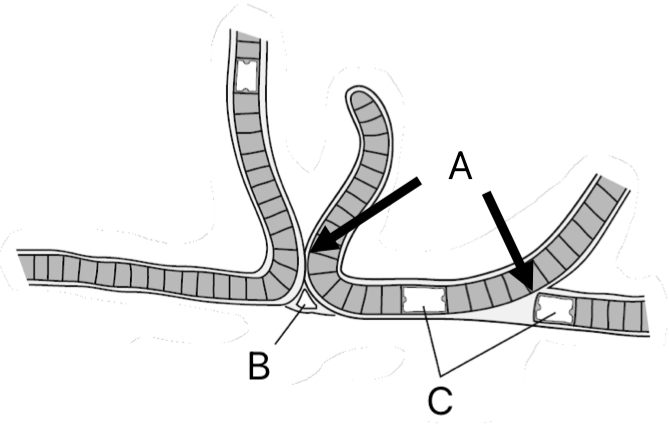
What are 2 types of false branching?
When a heterocyte forms
When a cell has died
What is true branching?
Produced by cell divisions perpendicular to the orientation of the main filament
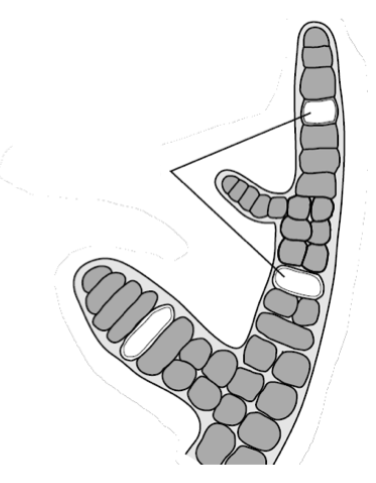
What does multiseriate mean?
Filaments are more than a single cell in width
What does uniseriate mean?
Filaments are a single cell in width
Do cyanobacteria reproduce sexually using gametes and meiosis?
No
List 4 types of cyanobacterial reproduction.
Binary fission
Fragmentation
Akinetes
Spores
What is binary fission?
Form of cell division
Allows one cyanobacterium to form 2 daughter cells of equal size
If these progeny become separated (do not form a filament or colony), the population increases
What is fragmentation?
Filamentous cyanobacteria can reproduce when filaments break apart into fragments
What are hormogonia?
Short, motile fragments produced by many filamentous cyanobacteria
Formed when separation disks (adjacent cells in the filament) undergo controlled death and collapse
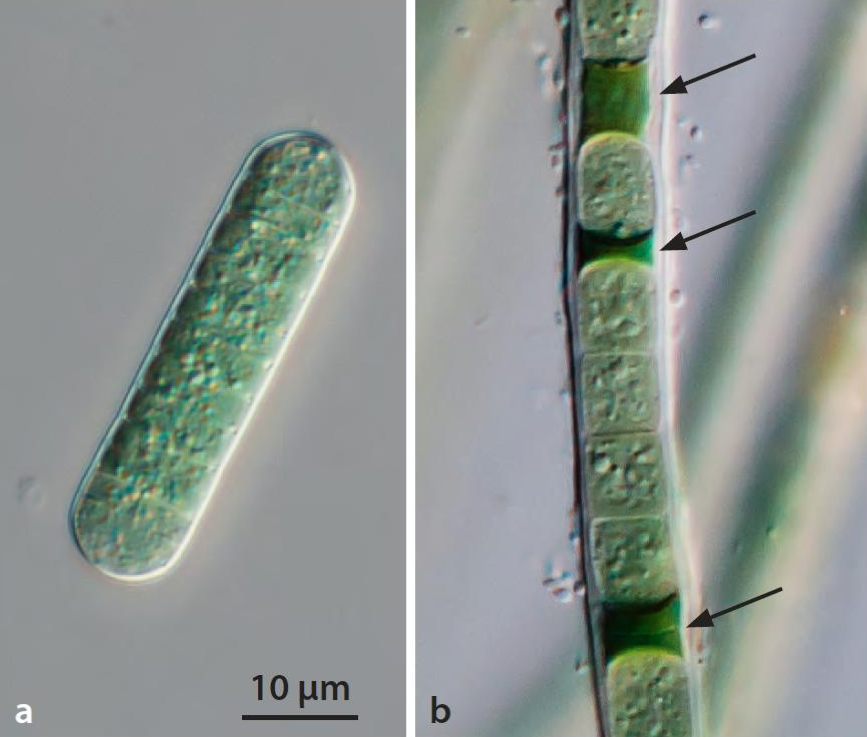
Label structures a and b.
a: hormogonium
b: separation disks
What are akinetes?
Specialized resting or dormant cells produced by heterocyte-forming filamentous cyanobacteria
Vary in appearance
Can better tolerate stress from temperature or nutrient levels than vegetative cells
Higher density allows them to settle to the sediment where they remain dormant until conditions improve
They then germinate, metabolize their storage compounds, produce gas vesicles, and rise through the water to produce new cyanobacteria

Label the structures indicated by the arrows.
Akinetes
How can akinetes be differentiated from heterocytes?
Akinetes generally have a larger size and more granular texture
How do akinetes have higher density than vegetative cells?
Large size
Thick cell wall
Many storage granules
Fewer gas vesicles

Label structures A and B.
A: akinete
B: heterocyte
What are spores?
Small, round cells produced by division of vegetative cells
Typically better at surviving unfavourable conditions than normal vegetative cells
List 2 types of spores.
Endospores/baeocytes
Exospores
What are endospores/baeocytes?
Spores that are produced internally within a vegetative cell, which then breaks open
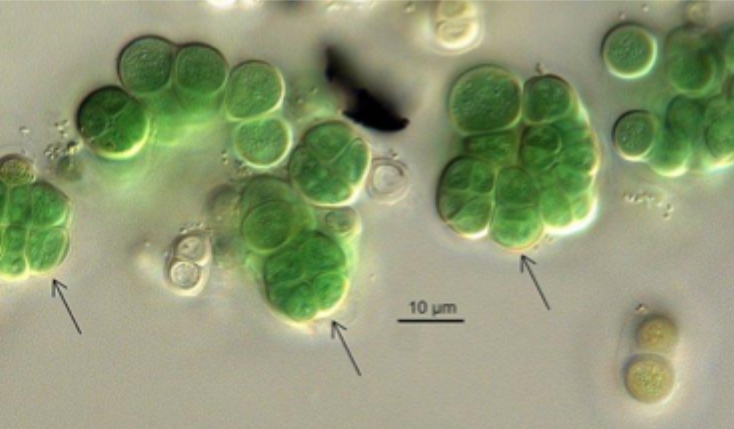
Label the structures indicated by the arrows.
Endospores/baeocytes
What are exospores?
Spores that bud off one end of the parent cell
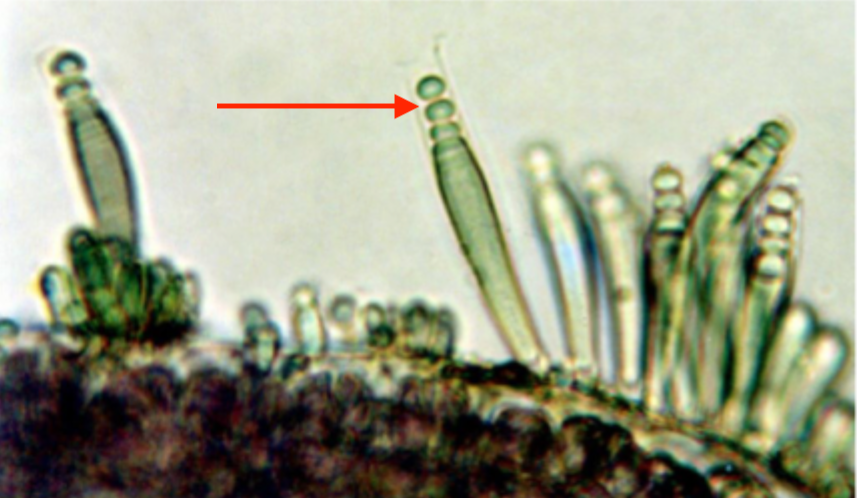
Label the structures indicated by the arrow.
Exospores
What is nitrogen fixation?
Conversion of nitrogen gas (N2) from the atmosphere into ammonia (NH4+)
Why is nitrogen fixation important?
Ammonia (NH4+) can be used to build amino acids, DNA or RNA nucleotides, ATP, and other nitrogen-containing molecules essential for life
Cyanobacteria can continue to grow in conditions that would otherwise have too little nitrogen
What does nitrogen fixation require?
An anoxic environment (without oxygen)
What are heterocytes/heterocysts?
Cyanobacterial cells with adaptations to reduce oxygen and increase energy production
Not photosynthetic
Thick cell walls reduce diffusion of oxygen into the cell
Can import carbohydrates from neighbouring cells to provide fuel for energetically expensive nitrogen fixation
Respiration produces energy in the form of ATP and also consumes oxygen, further reducing oxygen levels
What is the most common way for cyanobacteria to fix nitrogen?
Heterocytes
How can some cyanobacteria lacking heterocytes fix nitrogen?
Under anaerobic conditions
At night
List 7 functions of mucilage.
Colony formation
Nutrient absorption
Improved buoyancy
UV protection
Herbivore deterrence
Movement
Improved nitrogen fixation
What is an ocular micrometer?
A lens in the eyepiece of the microscope
Used to measure the size of a structure in ocular units (OU)
What is the calibration ratio for the 4x objective lens?
250 um/OU
What is the calibration ratio for the 10x objective lens?
100 um/OU
What is the calibration ratio for the 40x objective lens?
25 um/OU
What are green algae?
Known for their typically bright green colour, which they share with their close relatives the land plants
Individual lineages of green algae will contain species with and without flagella, with branching or unbranching filaments, and that are unicellular, colonial, or multicellular
What are the main differences between the green algal lineages?
Cellular
Metabolic
Ecological
Which 2 sister groups are green algae found in?
Streptophytes
Chlorophytes
Which group includes land plants and green algae?
Streptophytes
How were green algae historically classified?
According to their structure
What is convergent evolution?
Features evolved multiple times in different lineages
What is meiosis?
When cells go from diploid (2n) to haploid (n)
What is syngamy?
When cells go from haploid (n) to diploid (2n)
What is a dominant life stage?
Where mitosis creates a multicellular organism or increases population size
What is a haplontic life cycle?
A life cycle characterized by the presence of a dominant haploid (n) stage
What is a diplohaplontic life cycle?
A life cycle which alternates between dominant haploid (n) and diploid (2n) stages
What is a diplontic life cycle?
A life cycle characterized by the presence of a dominant diploid (2n) stage
What is a gametophyte?
A haploid (n) organism in diplohaplontic species
Undergoes mitosis to produce gametes
Germinates from spores
What is a sporophyte?
A diploid (2n) organism in diplohaplontic species
Undergoes meiosis to produce spores
Formed by fertilization of gametes
What does isomorphic mean?
In diplohaplontic organisms, when the diploid (2n) and haploid (n) forms are very similar in appearance
What does heteromorphic mean?
In diplohaplontic organisms, when the diploid (2n) and haploid (n) forms are morphologically distinct from each other
What does isogamous mean?
When gametes are more or less identical in size and shape
There are no male or female gametes, but there are different “mating types”, which can fuse
What does anisogamous mean?
When 2 gametes are produced with different sizes and/or motility
The small and motile gamete is usually the male
The larger, non-mobile gamete is female
What are placoderm desmids?
Monophyletic group found within the Zygnematophyceae
Where are placoderm desmids found?
Common in freshwater lakes and ponds
Particularly abundant in highly-coloured or low-nutrient waters
What are semi-cells?
Placoderm desmid cells constricted into 2 parts
What is the isthmus?
A narrow region that joins semi-cells in placoderm desmids
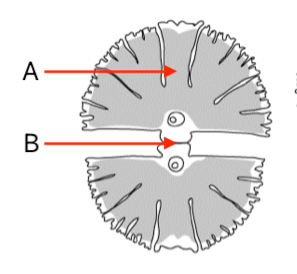
Label structures A and B.
A: semi-cell
B: isthmus
How do placoderm desmids move?
Secrete mucilage through pores in the cell walls
Some species secrete mucilage alternately from each tip of the cell, resulting in a tumbling movement
Other species screte mucilage from only one half of the cell, so when the mucilage abosrbs water, it swells and pushes the cell forward
How does asexual reproduction occur in placoderm desmids?
Mitosis
Each semi-cell receives one daughter nucleus and then produces new symmetrical semi-cells
How does sexual reproduction occur in placoderm desmids?
Haploid (n) vegetative cells produce gametes by mitosis
Gamete fusion produces a diploid zygospore, which undergoes meiosis to produce new haploid germlings
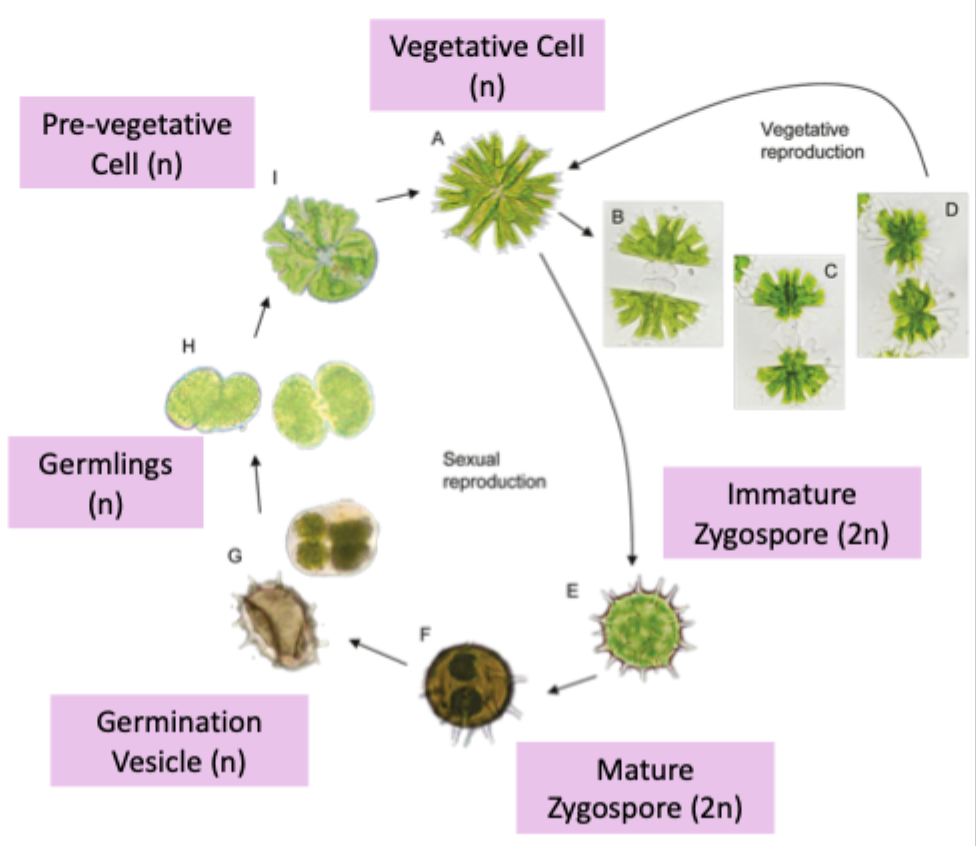
What type of life cycle do placoderm desmids have? How do you know?
Haplontic: dominant haploid stage
What are the Charophyceae?
Monophyletic group of freshwater green algae
Why is Chara among the best studied algae?
Close relationship to land plants
What is the thallus?
Vegetative body
What are oogonia?
Egg-producing reproductive structures
What are antheridia?
Sperm-producing reproductive structures
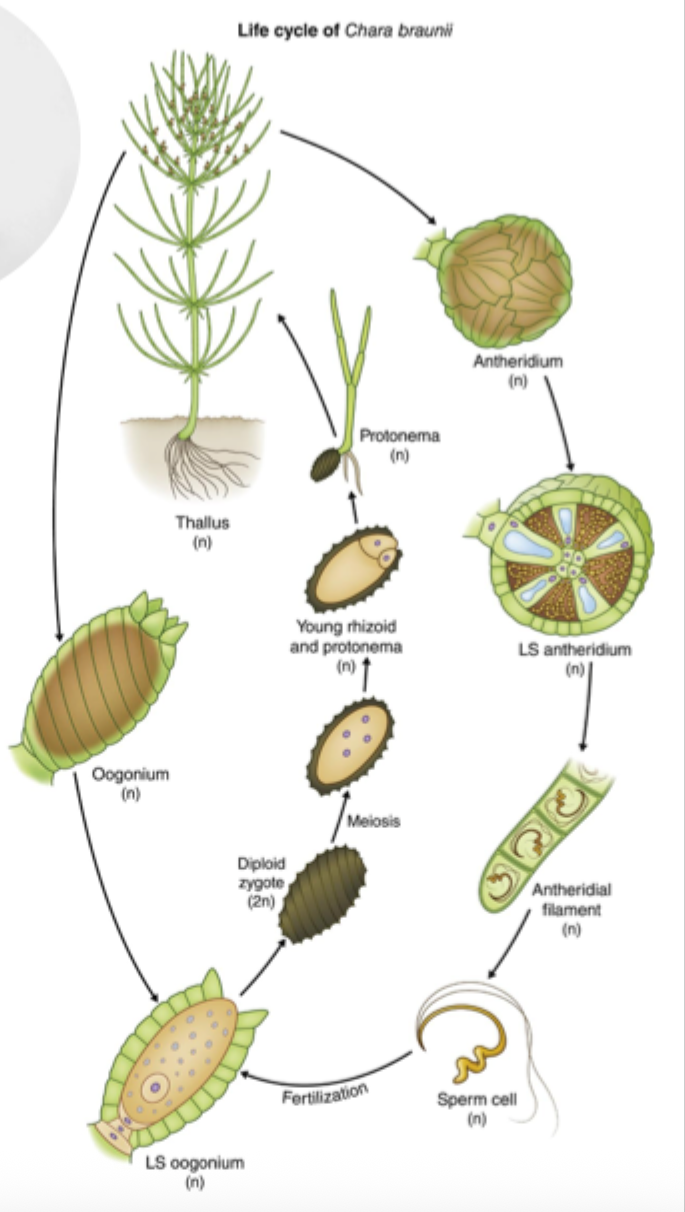
What type of life cycle does Chara have? How do you know?
Haplontic: dominant haploid stage
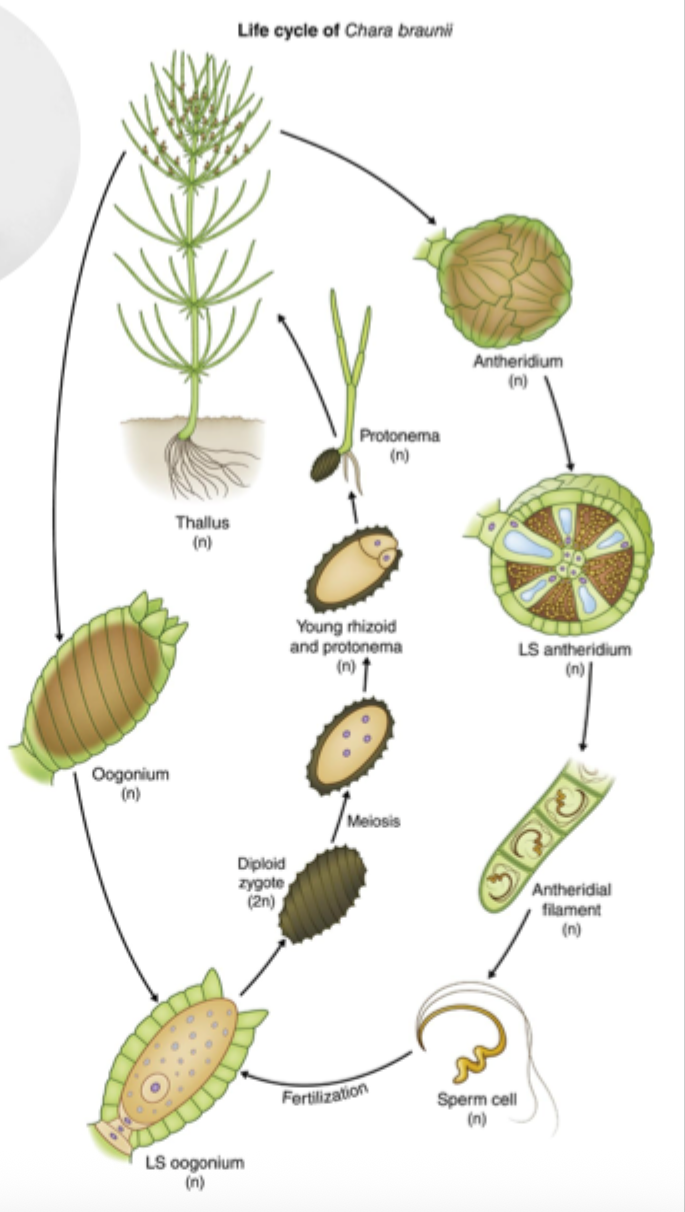
Is Chara isogamous or anisogamous? How do you know?
Anisogamous:
Gametes differ in size and motility
Large, immotile eggs
Small, motile sperm
List 3 different ways microscopic green algae can live.
Unicellular
Colonial
Multicellular
What does colonial mean?
Physically coordinated cells
What does multicellular mean?
Physical coordination and specialization of cell structure/function
List 2 types of colonies.
Flattened colonies
Spheroidal colonies
What are the Chlamydomonadales?
Algal order in the Chlorophyceae
Why are the Chlamydomonadales actively studied?
To better understand how multicellularity can evolve
How many flagella do most Chlamydomonadales have?
2
How many plastids do most Chlamydomonadales have? What shape are they?
Single cup-shaped plastid
What type of life cycle do the Chlamydomonadales have? How do you know?
Haplontic: dominant haploid stage
What regulates colony formation in Scenedesmus?
In the presence of a chemical produced by a zooplankton herbivore, Scenedesmus is stimulated to form colonies that are bigger, and therefore harder for the small zooplankton to eat
What are the Oedogoniales?
Monophyletic group within the Chlorophyceae
Includes Oedogonium and related genera
Freshwater species that grow on substrates in shallow waters
Can form large blooms, especially in nitrogen-rich wastewater
How does asexual reproduction occur in Oedogonium?
Motile zoospores form and are released from zygosporangium cells along the filament
How does sexual reproduction occur in Oedogonium?
The egg in a spherical oogonium is fertilized by sperm produced by smaller antheridium cells near the oogonium (macrandrous species) or on dwarf male filaments (nannandrous species)
The diploid (2n) zygote then undergoes meiosis to produce new individuals
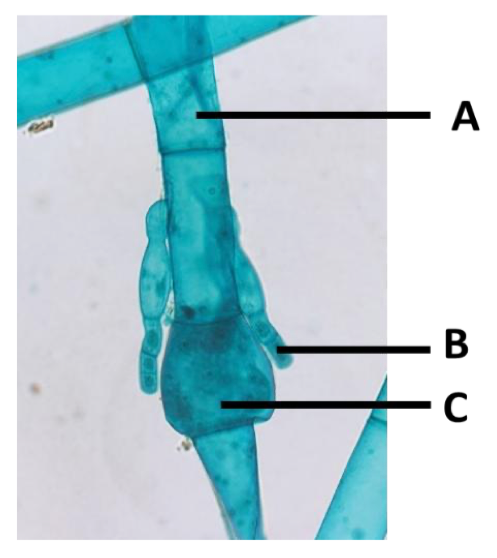
Label structures A-C.
A: vegetative cell
B: dwarf male filament
C: oogonium
What are the Ulvophyceae?
Polyphyletic group of green algae
The phylogeny has not been resolved
What is a dissecting microscope?
Important tool in the observation of biological specimens, especially for structures and features too small to observe easily by eye, but too large or bulky for a compound microscope
How does Hydrodictyon reproduce?
Each cell in the colony can produce a new colony
Leads to explosive population growth when nutrients are abundant
Huge blooms can clog waterways and accumulate in rotting masses on the shore
What does coenocytic mean?
Cells contain multiple nuclei